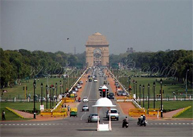|
|

|
|

|
|
|||
 The national capital territory of Delhi with an area of
1483sq.km is situated between the Himalayas and Aravalis range in
the heart of the Indian sub-continent. It is surrounded on 3 sides by
Haryana and to the east, across the river Yamuna by Uttar Pradesh. The
major part of the territory lies on the western side of the river Yamuna, only
some villages and the urban area of Shahdara lie on the eastern side of the
river. Its greatest length is around 33 miles and the greatest breadth is 30
miles. Delhi's altitude ranges between 213 to 305 metres above the sea
level.
The national capital territory of Delhi with an area of
1483sq.km is situated between the Himalayas and Aravalis range in
the heart of the Indian sub-continent. It is surrounded on 3 sides by
Haryana and to the east, across the river Yamuna by Uttar Pradesh. The
major part of the territory lies on the western side of the river Yamuna, only
some villages and the urban area of Shahdara lie on the eastern side of the
river. Its greatest length is around 33 miles and the greatest breadth is 30
miles. Delhi's altitude ranges between 213 to 305 metres above the sea
level.
Geography and physical features Physically the natural capital territory of Delhi can be divided into 3 segments - the Yamuna flood plain, the Ridge and the Plain. The Yamuna flood plains are somewhat low-lying and sandy and are subject to recurrent floods. This area is also called Khadar. The ridge constitutes the most dominating physiographic features of this territory. It originates from the Aravali hills of Rajasthan and entering the union territory from the south extends in a north eastern direction. It encircles the city on the north west and west. The point near Bhatti has a height of 1045 ft. Tughlaquabad fort is located on one of the highest spurs of the ridge. Leaving aside the Yamuna flood plain (khadar) and the ridge, the entire area of the national capital territory of Delhi is categorized as Bangar or the plain. A major proportion of the area of Delhi is plain and on this are located Delhi, New Delhi and Delhi cantonment along with a vast stretch of numerous villages. The land of the plain is mostly fertile.
In Delhi, there are 5 community development blocks comprising of 209 villages of which 199 villages are inhabited while the remaining ten villages are uninhabited. Delhi has an extreme climate which is very cold in winter and terribly hot in summer. The cold season begins in November and is at its peak around the time of the New Year and the Ist half of the January. After the middle of March, the weather begin to turn warm and soon it becomes hot so that from April to June one experiences extreme heat when the temperature climbs to 45oC at times. The monsoon arrives towards the end of June. Delhi has a rainy season in winter also. It is important for the farmers of the village of the union territory because the rabi crops benefits by it. Weather is generally dry except for 2-3 months of humidity. |